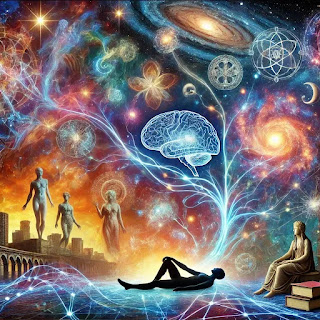How We Smell!
Scientific Aspects
1. Olfactory Receptors: The human nose contains around 400 types of olfactory receptors. These receptors are special proteins on olfactory cells located in the olfactory epithelium (a small patch of tissue inside the nasal cavity). Each type of receptor is sensitive to specific molecules or groups of molecules in the air.
2. Binding Process: When we inhale, molecules from the environment enter our nose. If these molecules fit the shape of certain olfactory receptors, they bind to them. This binding triggers a signal in the olfactory cells.
3. Signal Transmission: The signals from olfactory receptors are sent to the olfactory bulb, a small structure just above the nasal cavity, which processes these initial signals. The olfactory bulb then passes this information to other parts of the brain.
4. Brain Interpretation: The brain, especially areas like the olfactory cortex and limbic system, interprets these signals, translating them into specific smells. Since the limbic system is also associated with memory and emotion, certain smells can trigger memories or emotional responses.
5. Combinatorial Code: Unlike vision, which has only three types of receptors for color, our sense of smell relies on a combination of receptors. Different combinations create different smells, allowing us to detect and distinguish thousands of odors.
Broader Perspectives
1. Evolutionary Purpose: Smell evolved as a survival mechanism. It helps animals (including humans) detect food, recognize predators, locate mates, and identify changes in the environment.
2. Cultural Significance: Smell also has a significant cultural and personal dimension. Certain smells can be comforting, while others may be associated with specific cultures or memories. Fragrances and perfumes are crafted to appeal to human preferences and play an important role in fashion, rituals, and social interaction.
3. Impact on Behavior and Emotions: Smells can affect our mood and behavior. For example, lavender is often associated with calmness, while citrus scents may energize. This relationship is so strong that aromatherapy uses smells to support emotional well-being.
4. Unique Smell Profiles: Every individual has a unique "odor fingerprint," influenced by genetics, diet, health, and even environment. This uniqueness is why animals, particularly dogs, can track people by their scent.
5. Loss of Smell: The absence or loss of the sense of smell (anosmia) can profoundly impact a person’s quality of life, affecting their ability to enjoy food, detect hazards (like smoke or gas), and connect emotionally to familiar environments.
Here are some funny and unusual facts about the sense of smell:
1. You Smell Yourself All the Time:
Our brain filters out our own scent, so we don’t constantly smell ourselves. This is called "olfactory adaptation," where our nose becomes less sensitive to our own scent over time.
2. Humans Can Smell Rain:
That fresh, earthy smell after rain is called petrichor. It’s caused by a combination of compounds like geosmin (from soil bacteria) and oils released by plants during dry weather.
3. A ‘Smelly’ Fingerprint:
Just like a fingerprint, everyone has a unique “odor print.” Your body’s bacteria, diet, and even health conditions create a scent that’s unique to you, like your very own aromatic ID.
4. Our Noses Are a Bit Lopsided:
Each nostril doesn’t smell the same way! One nostril usually detects smells better than the other due to slight differences in airflow and the moisture level in each nostril.
5. Dogs Aren’t the Only Smell Pros:
Humans may not have a dog’s nose, but we can detect over a trillion different smells! We may not be able to track someone, but our range is still impressive.
6. You Smell in Stereo:
Our two nostrils work independently, so we smell in “stereo,” helping us locate the direction of smells in a similar way to how our ears locate sounds.
7. Fear and Happiness Are Contagious by Smell:
Humans can detect chemical signals of fear and happiness through sweat. Studies show that smelling "happy sweat" can improve mood, while fear signals can increase anxiety!
8. Old Books Have a Unique Smell:
That lovely “old book smell” comes from the breakdown of paper and ink, which releases volatile compounds like vanilla, almond, and even a bit of grassy scent.
9. Your Taste is Actually Mostly Smell:
When you eat, around 80% of what you "taste" is actually due to smell. This is why foods lose their flavor when you have a stuffy nose!
10. Your Nose Never Stops Smelling:
Even when you sleep, your sense of smell keeps working, acting like a mini alarm system. Unfortunately, it’s not strong enough to wake you up, but it could trigger bad dreams if it picks up an unpleasant scent.
In summary, our sense of smell is both a sophisticated scientific process and a deeply personal, cultural experience. It's an essential part of how we perceive and interact with the world. It may seem simple, but it’s packed with fascinating quirks!





Comments